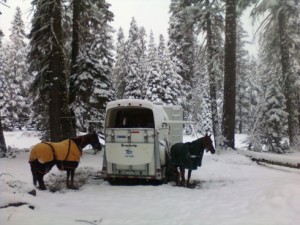Enjoying the Ride
By Paula Parisi December 1, 2011
Snow blanketed Lake Tahoe's higher elevations on the eve of the 2011 Tevis Cup Endurance Ride.
(Photo by Crockett Dumas)
While the article “Gearing Up for the Tevis Cup” in your October/November issue was overall very good, emphasizing the level of athleticism and skill necessary to take part in the event, there is one point I would like to correct.
Here at the Western States Trails Foundation, which maintains the trails and produces the Tevis Cup, we have always been referred to as an endurance ride, not a “race” (which is how it is mainly referred to throughout your article). Our national organizational umbrella is the American Endurance Ride Conference, not the American Endurance Race Conference.
Yes, it is true that there is a race within the ride, but the vast majority of the participants are taking part to ride, not race. The motto for endurance riding is “to finish is to win.” It isn’t accurate to refer to it as a race when only 10% of the entrants came to race and 90% came to ride. This is not a small distinction; it has to do with the whole concept of endurance riding. If the Tevis Cup ride is thought of as a race then the majority of the participants would find no reason to be there. It is about the pioneering experience of the journey.
The thing to compare it to is a marathon. If you were writing about the Boston Marathon, would you always refer to it as just a race? Wendell Robie, Julie Suhr, and Jim Steere all started the Tevis when they were 80 years old. In those years Wendell’s horse was pulled at Robinson Flat, Julie Suhr made it 99 miles and was over time, and Jim Steere finished, becoming the oldest person to successfully finish the Tevis.
In 2010 there was a woman, Melissa Margetts, who had shattered her right leg in a prior accident. She was unable to bear any weight on the leg and therefore could not ascend into a saddle. She was so determined to participate in Tevis that she taught her horse to lie down so she could mount and dismount at ground level. She successfully completed the Tevis ride. I maintain that stories such as these of people overcoming challenges to finish are what the Tevis is about much more than who wins the race.
Also, to clarify your comments regarding the entry fee: the fee if paid on time is $315. Entry fee with buckle is $465. For late entries add $100 to that. We have moved the entry deadline up in an effort to better plan and organize the ride.
This year, there was a lot of extra work to be done, due not only to the initial change in schedule, but also the extreme weather that hit the eve of the event. Within 24 hours the whole thing had to be reorganized with a new pre-ride camp site, start location, new trail and different sites for vet checks. Months of planning were compressed into a very hectic 24 hours and everyone associated with the event deserves to be congratulated.
Phil Gardner, Board Member
Western States Trails Foundation, CA
Short URL: https://theequestriannews.com/?p=7290


